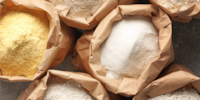
Guide
There’s more to bread than wheat: the diversity of grains
by Anna Sandner

The festive season is just around the corner and the smell of the Christmas spice par excellence is everywhere: cinnamon. But the aromatic bark is more than just a spice, it can also help your health. The choice between Cassia and Ceylon is crucial.
Cinnamon stars, speculoos, gingerbread, mulled wine and the like - everything around Christmas tastes of cinnamon. This can be good or bad for your health, depending on the type of cinnamon you're dealing with.
Cinnamon is obtained from the dried bark of various cinnamon trees (Cinnamomum). The two best-known varieties are Cassia and Ceylon. Ceylon cinnamon, also known as "true" cinnamon, comes from Sri Lanka (formerly Ceylon), Bangladesh, Burma and India. It has a milder, sweeter flavour than cassia cinnamon and is usually used in higher-quality products. Cassia cinnamon, on the other hand, grows in China and makes up the majority of the cinnamon we import. It is usually cheaper, has a strong, bitter flavour and is often used in industrial food production.
In traditional medicine, real cinnamon is considered a remedy for gynaecological, respiratory and digestive complaints. And modern science is also increasingly recognising the spice as a valuable health aid
Cinnamon is therefore particularly good in sweet Christmas biscuits. This is because it has the ability to regulate blood sugar levels. A review article on the medicinal properties of real cinnamon from 2013 emphasises that it can improve insulin sensitivity. This is particularly important for people with type 2 diabetes. By enhancing insulin action, cinnamon can facilitate the uptake of glucose into cells, helping to stabilise blood sugar levels.
Cinnamon also has anti-inflammatory and antioxidant properties, which can help to reduce chronic inflammation and protect the body from cell damage.
If you have read carefully, you can already answer this question yourself. The cited paper explicitly refers to "real" cinnamon, i.e. Ceylon cinnamon, for good reason. Although both types of cinnamon offer health benefits, there is one important difference: the coumarin content. Coumarin is a natural flavouring agent that can be harmful to health in high doses. Cassia cinnamon contains significantly more coumarin than Ceylon cinnamon. The researchers therefore recommend choosing Ceylon cinnamon, especially for people who eat a lot of cinnamon. This is because the high coumarin content of cassia cinnamon can potentially damage the liver if consumed regularly.
The different coumarin content is due to the production and the plant parts used in the cinnamon varieties. Cassia cinnamon is mainly obtained from the bark of the cinnamon tree Cinnamomum cassia. This bark is thicker and coarser, resulting in the characteristically hard and dark cinnamon sticks. In contrast, Ceylon cinnamon comes from Cinnamomum verum and is obtained from the inner, thinner layer of bark of two-year-old branches. This produces the more delicate, lighter-coloured and multi-layered "real" cinnamon sticks.

Because it is easier and cheaper to produce, cassia cinnamon is generally cheaper and therefore widely used in the food industry. Cinnamon is often not specifically labelled, which suggests that it is the cheaper cassia cinnamon. If the higher quality Ceylon cinnamon is used, this is usually explicitly labelled on the packaging. So if you value Ceylon cinnamon, you should pay close attention to the labelling.
Science editor and biologist. I love animals and am fascinated by plants, their abilities and everything you can do with them. That's why my favourite place is always outside - somewhere in nature, preferably in my wild garden.